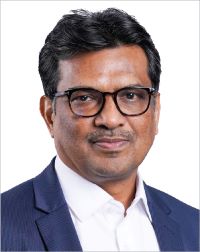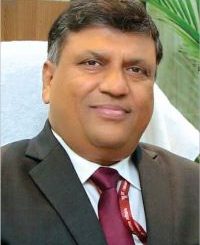
Hitachi Energy closed the last year on the highest-ever order backlog comprising several orders for renewable energy evacuation and integration, strengthening and expansion of state distribution networks, and rail electrification. The growing focus on energy transition, electrification of industries and railways, increase in data centre investments and continued focus on renewables have been the key growth drivers for the company’s business. In a recent interview with Power Line, N. Venu, MD and CEO, India & South Asia, Hitachi Energy, shared his views on the current state of the power sector, the issues and challenges facing it, and the company’s future plans. Edited excerpts…
What is your assessment of the current state of the power sector?
Already among the top five economies today, India is losing no momentum in its socially focused, environmentally responsible, economic transformation. It has resolved to ensure a sustainable future for the world’s largest population and for the generations to come. Leading by action, India has set ambitious goals of becoming carbon neutral by 2070, with critical intermediary 2030 targets such as integrating 500 GW of renewables in our national grid and meeting 50 per cent of the country’s energy requirements through renewables. Focused policy strategy is facilitating the journey towards carbon neutrality – from incentivising corporates to move to green sources for their energy requirements, production-linked incentives to build a manufacturing base for technologies such as batteries and solar panels, and encouraging adoption of electric vehicles and solar rooftops. Our grids need to be made flexible and secure as industries, mobility and urbanscape decarbonise.
How do you rate the performance of the power sector in advancing energy transition? What are the new technologies and solutions that can help fast-track India’s decarbonisation plans?
The past year was marked by some historic reforms toward capacity building for renewable energy sources, domestic manufacturing for renewables, electric mobility, coal gasification as well as the launch of the National Green Hydrogen Mission demonstrating the strong will of the government to help the country achieve its energy transition goals. The government also announced an inter-state transmission system for connecting and transmitting the upcoming 500 GW renewable energy capacity to load centres. With such programmes, it is expected that in 2050, coal will command around a quarter of India’s electricity generation, while wind and solar will account for two-thirds. Some technologies that will be crucial for future are as follows:
- New-age switchgear that are eco-efficient, reduce the use of resources, and have a smaller environment footprint throughout their life cycle.
- Offshore wind has the potential to generate over 420,000 TWh per year worldwide. To harness this energy, we need proven power technology and equipment that can address the unique challenges of the offshore energy environment.
- There will have to be an increase in digitalisation and automation for greater integration of renewable energy sources into the power system. Also, asset and work management software that enables asset-intensive industries and utilities to be more adaptive, collaborative, insightful and predictive is the need of the hour.
- As we embrace digitalisation, there is a greater risk of cyber disruption from external sources. Moving into the digital age with certainty requires automated, evolving and resilient cybersecurity solutions that help meet the most rigorous international standards as well as all products and systems.
- Last but not least, while high voltage direct current (HVDC) has already been used in landmark projects, the technology will gain momentum in India over the next 5-10 years due to its high efficiency in transmitting large amounts of electricity over long distances, integrating renewables and interconnecting grids.
What is your outlook for the power sector? How do you see the sector shaping up in the near to medium term? What are some of the key opportunities for equipment providers?
In its report for 2023, the Intergovernmental Panel on Climate Change has given its “final warning”, underscoring that the rising amount of greenhouse gas emission has pushed the world to the brink of irrevocable climate change damage. The climate and energy crises demand urgent action. Our society needs an evolved power system with electricity as the backbone.
The world is increasingly moving to non-polluting technologies. By 2050, electricity will constitute half of the world’s energy system vs the current 20 per cent. India has set itself a long-term ambition of net zero by 2070. The country’s 2030 ambitions include halving its energy intensity, quadrupling its renewable energy consumption to 500 GW, and converting 70 per cent of its commercial passenger vehicle fleet to electric. From electrification of rail to commercial and passenger vehicles to decarbonisation of heavy industries, digitalisation of utilities and increased data centres, and an overall increase in per capita electricity consumption.
What are the unresolved issues in the sector?
We have to recognise that the sector is fast evolving. Several stakeholders are on this journey, yet they may all not be at the same stage. Trusted partnerships and collaborations are essential for finding the solutions our world needs.
Recently, we witnessed policy discussions around making energy storage mandatory for renewable energy projects of more than 5 MW. The Central Electricity Authority has estimated that India requires over Rs 4.47 trillion for the expansion of energy storage by 2032. The central government has approved Rs 37.6 billion of viability gap funding to support battery energy storage systems. These actions and announcements will all help to move towards the same goal.
For renewables and clean energy to be truly accessible, the grids need to be modernised, made flexible and more secure. And this is a point that needs attention today for a sustainable tomorrow. We must stop viewing the grid as a fixed/static industrial asset and recognise that it is, in fact, highly dynamic. The energy networks’ supply has to match demand in real time. In addition, high voltage interconnectors that keep electricity flowing across geographies and balance out intermittencies will be essential, and, for these to come to fruition, we will need political congruity.
What have been the key business highlights for Hitachi Energy in the past year or so?
Energy transition, electrification of industries and rail, pick up in data centre investments and continued focus on renewables drove orders. We closed the year with the highest-ever order backlog that constituted several orders for renewable energy evacuation and integration studies, infrastructure projects, green corridors and state distribution networks, Scott transformers for Vande Bharat and other rail electrification orders. We also had several firsts including India’s first HVDC city-infeed link, integration of the largest solar parks in the country, and orders for powering data centres of the world’s most comprehensive cloud platform. To continue to be a key player in the global power technology supply chain, we invested in four new facilities.
- We set up the first manufacturing facility in India producing Resin Impregnated Paper bushings up to the 400 kV voltage level;
- A new factory to double our high voltage power quality capabilities;
- A new factory for the production of operating mechanism of circuit breakers;
- An advanced power system factory to manufacture advanced power electronics for HVDC Light®, HVDC Classic, and STATCOM, together with the MACH™ control and protection system
What are your top priorities for Hitachi Energy? What are the company’s future plans?
Hitachi Energy is at the centre of the energy transition and well positioned to help accelerate these fundamental changes with the purpose-driven growth encompassed in our “2030 plan”. Under this plan, we will continue to deliver the record-high order backlog in line with customer and partner commitments, hence securing and accelerating earnings and cash growth. Secondly, our focus will be on growing our presence in the digital services space, expanding at the edge of the energy system. Last but not least, we will continue to drive innovation, synergies with customers and the Hitachi Group companies, as well as find new partnerships to accelerate growth. While continuing to deliver to traditional customers, that is, utilities, growth in core business will be attributable to high growth segments outlined in our strategy – solar, wind, HVDC, data centres and rail – along with using the levers of service and exports.
The renewable energy market, with the current installed capacity of solar at 60.8 GW and wind energy at 41 GW, is poised for 5x and 3x growth respectively. We have offerings for the renewable energy market such as electrical balance of system optimisation, evacuation substation, energy and grid management automation, dry-type transformers. Over the next 8-10 years, we anticipate HVDC connections for utility-scale solar generated at Leh, Kargil, Bhadla, etc. The data centre market in India is expected to add 45 data centres spanning about 13 million sq ft and 1,015 MW of IT capacity over the next three years. We provide substations, GIS, automation solutions, dry transformer for data centres. Indian Railways, the world’s fourth-largest rail network, is undergoing massive upgradation and expansion led by the electrification of rail and the adoption of energy-efficient systems. It has already announced various sizeable tenders for high density corridors under Mission Raftaar.
Our formula to achieve success remains “diversity + collaboration = great innovation”. So, we will continue to invest in our talent, build a diverse talent base for tomorrow’s energy systems, and expand and diversify our world-class manufacturing base in India.



